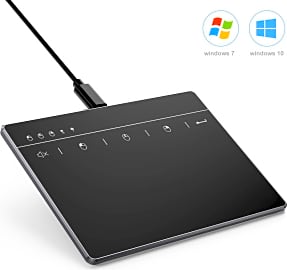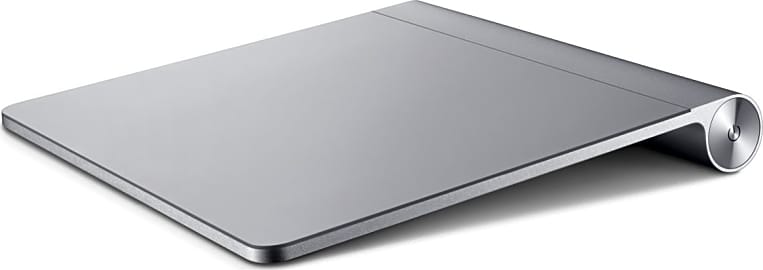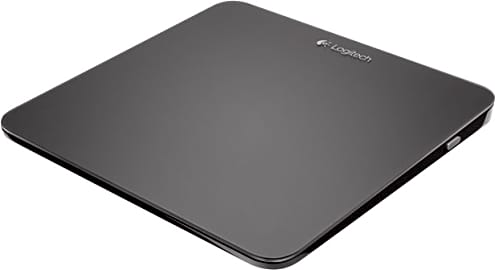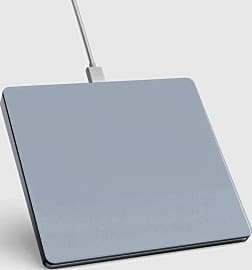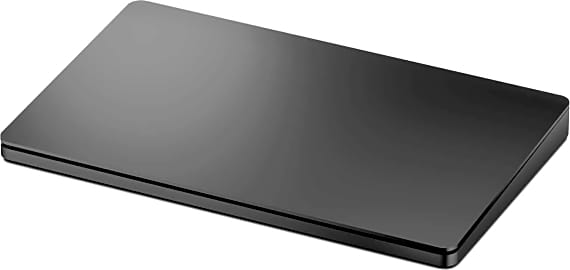The 10 Best Computer Touchpads

This wiki has been updated 37 times since it was first published in October of 2015. Touchpads are essential to most laptops, but they're rarely found on desktop keyboards. So if you've grown quite comfortable using the trackpad format, one of these aftermarket options will add convenient functionality to almost any computer. The right selection can help to relieve hand and wrist strain without sacrificing control, and some will even enable complex gesture inputs. When users buy our independently chosen editorial selections, we may earn commissions to help fund the Wiki.
Editor's Notes
November 13, 2020:
While there have been some advances in computer trackpads in recent years, most of these improvements are primarily found in the touchpads integrated into new laptops. There are few external pads that offer features like haptic feedback, though that may change in the not-too-distant future. It wasn't long ago that multi-touch gesture support was uncommon, but now it's a, more or less, standard feature.
If you're using an Apple computer, the Apple Magic Trackpad 2 is the easy choice. Its ability to sense the amount of pressure being used allows for a number of shortcuts and intuitive interactions. If that's a bit too expensive for you, or if your Mac is running on an older operating system, the Apple Magic Trackpad Original is still an impressive piece of hardware, and showcases how the company has been setting the standard for trackpads for some time now.
PC users have a number of options to choose from. The Jelly Comb T066P offers good response time and precise cursor control for a very reasonable price, though the programmable buttons and stylus support of the Wacom Intuos Pro will be tempting, especially for digital artists. The Logitech T650 has been well-received by the tech community, though some buyers may have a hard time justifying the high cost.
Previous versions of this list included options that were built into keyboards, though this time around, we didn't find any that were of a comparable quality to these stand-alone devices. In the end, any of these should be a solid alternative to a traditional mouse, so as long as it's compatible with your operating system and hardware, you won't have much to worry about. Choose the one with features and a price most in line with your needs, and you'll likely be happy with your purchase.
November 08, 2019:
If you prefer to use a touchpad over a mouse when using your desktop, you've probably had trouble finding a good one, especially if you don't use a Mac. With that in mind, you could consider using a touch mouse or even switching to a touchscreen monitor, although the latter could constitute too large a shift for many users. Of course, if you do use a Mac, you'll want to go with the Apple Magic Trackpad 2 or Apple Magic Trackpad Original, which are hands-down the best trackpads for desktop use.
For those of us who aren't invested in the Apple ecosystem, though, there are some good options. The Logitech T650 and Dell TP713 are both quite popular, but at this point they're so expensive that unless you can find a good used one, they're tough to recommend very strongly. If you need something that will hold up to heavy-handed users and possibly the general public on a shared-use computer, the Perixx Peripad may be worth a look, though it just doesn't feel the best to the fingers.
There are a couple options that you might not normally consider; the Logitech Touch Lapdesk and Logitech K400 Plus are two of them, and while they are combinations of keyboards and touchpads, the touch component does work quite well. But if you use a desktop PC, the Lapdesk is out, and if you don't need a new keyboard, the K400 won't help you much. If you need something with extremely high precision that works with Windows, the Wacom Intuos Pro may be your best bet; while quite costly, it is of extremely high quality, once you get it working right.
But most Windows users should check out the two simplest. The Seenda Multi-Touch is nice because you can see where to touch to register a button press, while the Jelly Comb T066P is designed to almost perfectly emulate the average laptop trackpad.
Special Honors
AirBar Touchscreen Sensor If you're looking for other ways to interact with your computer, this nifty device will transform the monitor of just about any computer into a touchscreen, letting you tap icons and links directly on your screen. You can even use multi-finger gestures to zoom or scroll. Simply mount it to your screen and plug it into a USB port, and you'll be ready to start treating your traditional monitor like a tablet. air.bar
How Computer Touchpads Work
Capacitive touchpads are known for being more accurate and won't accidentally register touches from the tip of a pencil or other inert object as conductive touchpads do.
Touchpads can be based on one of two different types of technologies: capacitive or conductive. Conductive touchpads contain multiple layers of material. The uppermost layer is the one the user touches, while the lower layers contain rows of vertical and horizontal electrodes. Each of these layers is separated by a super thin layer of insulation. At the very bottom of all of these layers is a circuit board that all of the electrodes are attached to.
The electrode layers are charged with an alternating current, and when the user's finger touches the upper touchpad layer, it is slightly depressed causing it to make contact with the lower electrode layers. This creates an interruption in the current and registers on the circuit board. The initial touch point of the user's finger is plotted on the touchpad and any movement afterwards is related to that initial touch point. This is how a touchpad knows how far to move the cursor on the screen.
Currently, capacitive touchpads are more common than conductive. With a capacitive touchpad, the layer the user touches holds the electrical charge which creates a vertical and horizontal array, much like a grid. When the user touches a capacitive touchpad, it plots the coordinates, very similar to the way a map user identifies a location based on the longitude and latitude grid. Once the touchpad determines the location of the user's finger, it converts it to a specific location on the computer screen.
Capacitive touchpads are known for being more accurate and won't accidentally register touches from the tip of a pencil or other inert object as conductive touchpads do. This can be problematic for those wearing gloves as the touchpad won't register a touch from a gloved finger either.
Most touchpads come with a number of additional features as well. Some common features seen in touchpads include interpreting a tap or double tap as the click of a mouse button, and the use of multiple fingers for scrolling and panning. Many often feature areas the user can depress just like clicking a standard mouse, or hotspots with pre-programmed functionality.
History Of The Computer Touchpad
The first touchpads were integrated directly into the keyboard of 1982 Apollo desktop computers. Just one year later in 1983, the Gavilan SC laptop computer also included a touchpad, which was located just above its keyboard. This also happened to be the first computer ever marketed as a laptop. It featured a unique clamshell design in which the screen folded down over the keyboard for protection.
This also happened to be the first computer ever marketed as a laptop.
The first capacitive touchpad was invented in 1988 by George E. Gerpheide and, in 1994, it was made commercially available and marketed as the GlidePoint. Apple was the first company to license the GlidePoint and they incorporated it into their 1994 Powerbook laptops.
As more companies began to incorporate touchpads into their laptops in the mid 1990s, there was no agreed upon term for them. This caused much confusion among consumers, as one company may call it a touchpad, while another may refer to it as a GlidePoint, and others still were calling it a touch sensitive input device, or simply, a trackpad.
Even today there is no commonly agreed upon term for touchpads, but buyer confusion has dissipated with time and understanding that the definitions of these devices are synonymous with one another. Interestingly enough even today's companies, like HP and Lenovo identify them as touchpads, while Apple labels them as trackpads. Some software manufacturers even call them clickpads.
Despite their various names, they are currently the most popular navigation device for laptop computers, and many desktop users are buying external touchpads because of the many additional features they offer over a standard computer mouse.
Understanding Standard Windows Touchpad Gestures
Understanding all of the different gestures your touchpad is capable of is key to getting the most out of it. Efficient use of a touchpad relies on having a working knowledge of its shortcuts, and they are capable of some much more than just moving a cursor and clicking on a program or file.
To see all open windows at one time, place three fingers on the touchpad and swipe up and away from you.
Zooming in and out with a touchpad can be accomplished by placing two fingers on the pad and then either pinching them together, to zoom out, or stretching them out, to zoom in. One can also scroll up and down by placing two fingers on the touchpad and swiping up or down. This also works for horizontal panning, but instead of swiping up or down, one must swipe left or right.
Hovering the cursor over a file and then placing both fingers of the touchpad for a second or two without releasing will function just like right clicking with a standard mouse and bring up additional options that can be performed on files and programs.
To switch between open windows or programs, one can place three fingers on the touchpad and swipe left or right. To see all open windows at one time, place three fingers on the touchpad and swipe up and away from you. To immediately return to the desktop, perform the opposite maneuver by placing three fingers on the touchpad and swiping towards yourself. A three finger single tap can also be used to bring up the Cortana search feature.
The above are standard features on all computers using Windows 10. One can also go into the touchpads settings and choose which features they enjoy using, and which they would prefer to be disabled.



